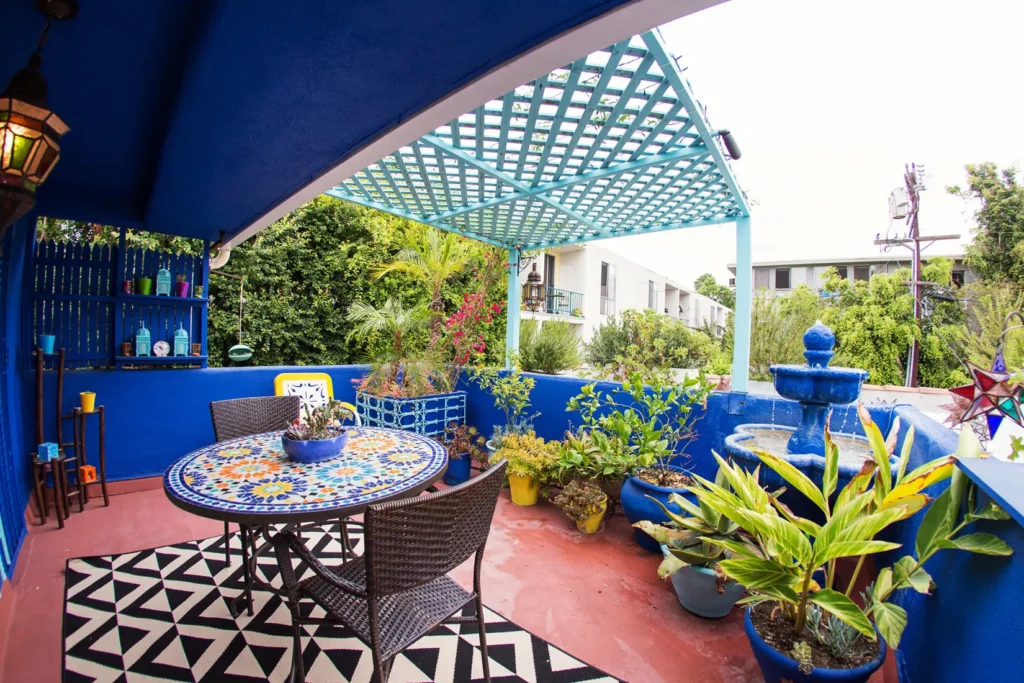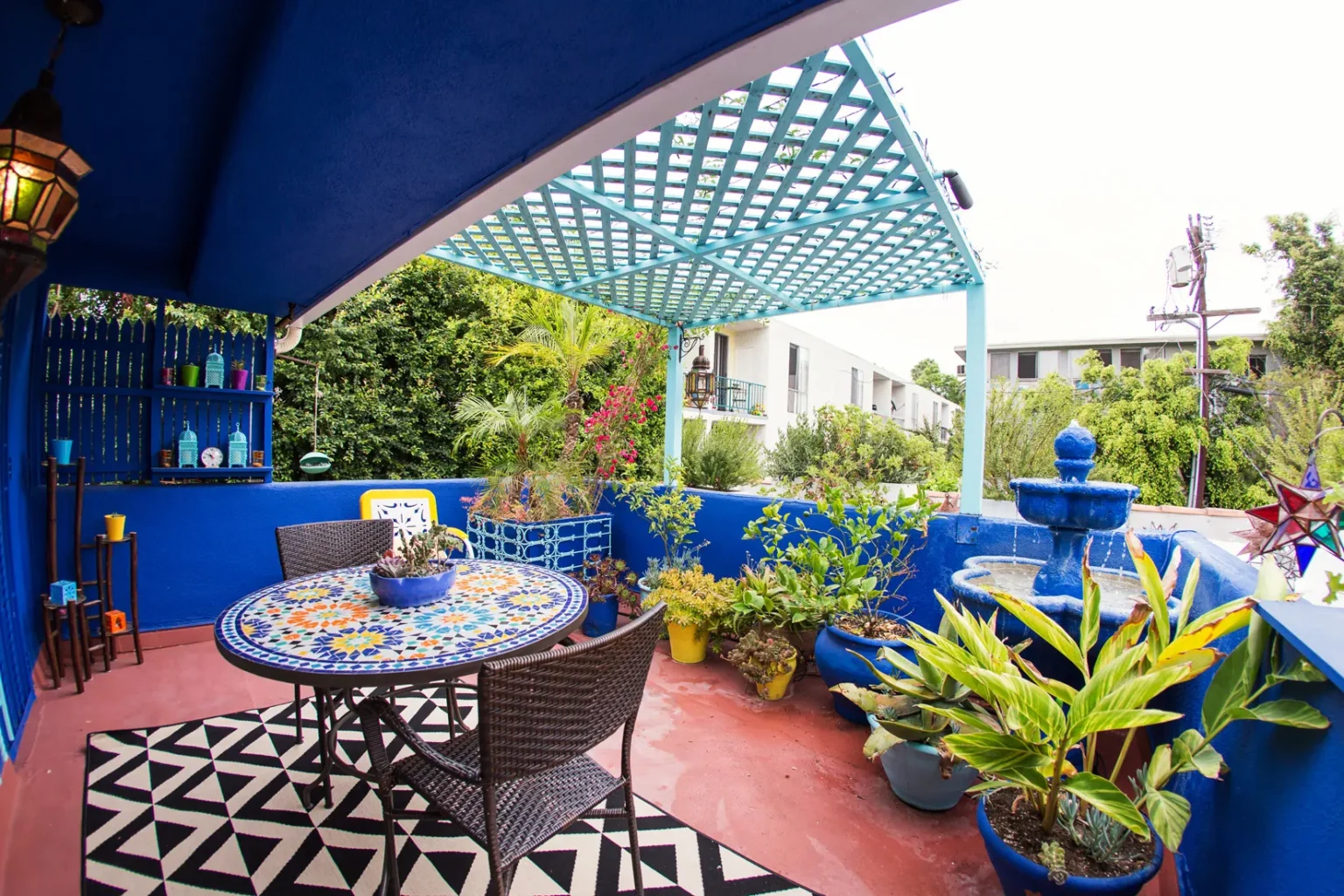
Imagine stepping into a space where vibrant colors dance under the sun, intricate patterns whisper tales of ancient craftsmanship, and the air carries a faint scent of mint tea. A Moroccan outdoor seating area brings this vision to life, blending exotic charm with cozy comfort. Rooted in Morocco’s rich cultural heritage, this style transforms patios, gardens, or balconies into inviting retreats. It’s not just about aesthetics; it’s about creating a sensory experience that feels both luxurious and grounded. Whether you’re a design enthusiast or simply seeking a unique backyard escape, crafting such a space is achievable with thoughtful planning. This article will guide you through every step, from selecting authentic elements to arranging them for maximum comfort and appeal. By the end, you’ll have a blueprint for a seating area that’s as functional as it is enchanting.
Understanding Moroccan Design Principles
Moroccan design is a tapestry of influences—Berber, Arab, and Mediterranean—woven together over centuries. It thrives on bold contrasts: think deep jewel tones against earthy neutrals or smooth tiles paired with rough textiles. Symmetry and geometry play starring roles, seen in arched doorways and star-shaped patterns. Yet, it’s the layering of textures—woven rugs, carved wood, wrought iron—that gives it depth. For an outdoor seating area, these principles translate into a balance of opulence and practicality. The goal isn’t sterile perfection but a lived-in warmth that invites relaxation. Natural materials like stone and clay ground the space, while pops of color from cushions or lanterns add vibrancy. Understanding this fusion is key to avoiding a cluttered or inauthentic look.
Choosing the Perfect Location
Location sets the stage for your Moroccan oasis. A corner of your garden with dappled shade from a tree works beautifully, mimicking the courtyards of Moroccan riads. If you’re urban-bound, a balcony or small patio can suffice—size isn’t the limiter, creativity is. Consider sunlight: too much can fade fabrics, while too little dims the vibrant palette. Wind exposure matters too; delicate lanterns or lightweight textiles might not fare well in gusty spots. Proximity to a water feature, like a fountain, enhances the ambiance with soothing sounds, a nod to traditional Moroccan gardens. Assess your space for privacy—trellises or screens can shield it from prying eyes. The right spot feels secluded yet accessible, a retreat that’s part of your daily life.
Selecting Moroccan-Inspired Furniture
Furniture anchors your seating area, and Moroccan style favors low, lounging pieces. Opt for a wooden daybed with carved details or a wrought-iron bench softened with cushions. Low tables, often hexagonal or octagonal, reflect geometric motifs and double as surfaces for tea trays. Avoid bulky modern sets; instead, seek handcrafted items with a weathered patina for authenticity. Teak or cedar withstands outdoor conditions, though a protective sealant helps. For smaller spaces, foldable stools or poufs offer flexibility without sacrificing style. Source pieces from artisans or retailers specializing in North African decor—West Elm often carries inspired designs. Comfort is non-negotiable, so test for sturdiness and pair with plush seating pads.
Layering Textures with Textiles
Textiles are the soul of Moroccan coziness. Start with a base layer: a kilim or Berber rug in bold reds, blues, or creams. These aren’t just decorative; they define the seating zone and soften hard surfaces like concrete. Add throw pillows in silk or cotton, mixing patterns like stripes and arabesques—don’t shy away from controlled chaos. Blankets draped over furniture invite snuggling on cooler evenings; choose lightweight wool or cotton in mustard or saffron hues. Outdoor fabrics treated for UV and water resistance, like those from Sunbrella, ensure longevity. Layering isn’t random—stick to a cohesive color family to tie it together. The result should feel tactile and rich, urging you to sink in and stay.
Incorporating Vibrant Colors
Color is Moroccan design’s heartbeat. Jewel tones—emerald, sapphire, ruby—evoke the souks of Marrakech, while earthy ochres and terracottas ground the palette. Paint a wall or fence in a warm clay shade for a backdrop, or keep it neutral and let accessories pop. Cushions, rugs, and ceramics are your canvas for bold hues; a single accent color, like turquoise, can unify the scheme. Balance is crucial—too many brights overwhelm, so intersperse with whites or beiges. Moroccan style embraces imperfection, so slight fades or variations add charm. For inspiration, explore Architectural Digest’s takes on global palettes. Your seating area should glow with life, not clash.
Adding Authentic Moroccan Lighting
Lighting transforms your space from day to night. Moroccan lanterns—metal frames pierced with filigree or stained glass—cast mesmerizing patterns. Hang them from pergolas or tree branches, or cluster them on tables for intimacy. Brass or copper finishes age gracefully outdoors; seal them against rust if needed. String lights with a warm glow mimic starry skies, draping over railings or trellises. Candles in ceramic holders add a soft flicker—opt for citronella to ward off bugs. For durability, choose solar-powered or LED options from brands like Luminary. Placement matters: stagger heights to create depth. The effect should feel magical, drawing you in after sunset.
Enhancing with Moroccan Decor Elements
Decor elevates functionality to art. Mosaic tiles on a tabletop or as a border nod to Moroccan craftsmanship—zellige patterns in blue and white are timeless. Ceramic pots with hand-painted motifs house plants or serve as accents; group them for impact. A small fountain or basin, even a DIY version, echoes riad courtyards—check HGTV for tutorials. Wrought-iron screens or wooden lattices add privacy and texture. Avoid overstuffing; each piece should breathe. Thrift stores or online marketplaces like Etsy offer unique finds. These touches weave a story, making your space distinctly Moroccan.
Integrating Plants for a Lush Feel
Plants bring your seating area to life, softening edges and adding fragrance. Olive trees in terracotta pots channel Mediterranean vibes, while citrus varieties like lemon or orange hint at Moroccan groves. Trailing jasmine or bougainvillea climbs trellises, spilling color and scent. Succulents or cacti thrive in arid climates and fit smaller spaces. Herbs—mint, rosemary—double as decor and tea ingredients. Arrange in clusters at varying heights for a natural flow; avoid rigid lines. Drainage is key for outdoor pots—ensure they’re weatherproof. The Spruce offers care tips for exotic plants. Greenery should feel abundant yet curated, enhancing the cozy retreat.
Creating a Functional Layout
A well-planned layout ensures comfort and flow. Position seating in a U-shape or circle around a central table, fostering conversation—Moroccan culture prizes communal relaxation. Leave room to move; a cramped space kills the vibe. Face furniture toward a focal point—a fountain, plant cluster, or view. If shade’s limited, a pergola or canopy works wonders; drape it with fabric for drama. Define zones: a rug marks the lounge, while a side table holds essentials. Test the setup—sit, walk, adjust. It should feel intuitive, not forced. Functionality meets beauty when every element serves a purpose without sacrificing style.
Weatherproofing Your Moroccan Space
Outdoor living demands durability. Seal wooden furniture with marine-grade varnish to fend off rain; reapply yearly. Cushions and rugs in weather-resistant fabrics hold up better—store them during storms. Metal decor needs rust-proofing; powder-coated iron lasts longer. Tiles or stone flooring should be non-slip and frost-resistant if winters are harsh. A retractable awning or tarp protects from sudden downpours—Better Homes & Gardens has affordable options. Check drainage; pooling water ruins textiles fast. Regular maintenance—sweeping, spot-cleaning—keeps it pristine. Weatherproofing preserves your investment, letting the space shine year-round.
Comparison Table: Moroccan vs. Modern Outdoor Seating
| Feature | Moroccan Style | Modern Style |
|---|---|---|
| Furniture | Low, ornate, handcrafted | Sleek, minimalist, mass-produced |
| Colors | Bold jewel tones, earthy | Neutral, monochromatic |
| Textiles | Layered, patterned | Simple, solid |
| Lighting | Lanterns, warm glow | LED, cool tones |
| Decor | Mosaic, ceramic | Metal, glass |
This table highlights how Moroccan design prioritizes warmth and heritage over modern simplicity, guiding your choices.
Maintaining Your Moroccan Oasis
upkeep keeps your seating area inviting. Dust lanterns and furniture weekly; a damp cloth works for metal and wood. Wash textiles seasonally—follow care labels to avoid fading. Inspect for wear: cracked tiles or frayed rugs need prompt repair. Store delicate items in winter; a shed or indoor nook suffices. Prune plants to maintain shape and health; water consistently but don’t drown them. Refresh paint or sealant every couple of years for vibrancy. Small efforts preserve the magic, ensuring your space remains a cozy haven.
Budgeting for Your Moroccan Retreat
Cost varies with ambition. A basic setup—rug, cushions, lanterns—starts at $200-$300. Handcrafted furniture or tiles push it to $500-$1,000. Thrifted finds cut expenses; DIY projects like painting pots save more. Splurge on one statement piece—a carved table or fountain—then build around it. Quality textiles and weatherproofing add upfront cost but reduce replacements. Plan purchases over months if needed; sales on Wayfair help. A cozy Moroccan space doesn’t demand a fortune—just strategic spending and creativity.
Bringing It All Together
Execution ties the vision together. Start with your location, then layer furniture, textiles, and decor in stages. Test each addition—does it enhance comfort or clash? Adjust as you go; Moroccan style thrives on evolution. Invite friends for tea to break it in—the space should spark joy and connection. Tweak lighting or plants until it feels right. The process is as rewarding as the result, turning a corner of your world into a Moroccan escape.
FAQs About Moroccan Outdoor Seating Areas
What makes a seating area distinctly Moroccan?
It’s the blend of bold colors, intricate patterns, and layered textures—think low furniture, kilim rugs, and filigree lanterns—rooted in cultural heritage.
Can I create this on a small balcony?
Yes, scale down with poufs, a small rug, and hanging lanterns. Focus on vertical space with plants or screens for that cozy feel.
How do I protect it from weather?
Use weather-resistant fabrics, seal wood and metal, and store cushions during harsh conditions. A canopy adds extra shelter.
What’s a must-have element?
A Moroccan lantern—it sets the mood with patterned light and ties the aesthetic together effortlessly.
Conclusion: Crafting Your Moroccan Haven
A Moroccan outdoor seating area is more than decor—it’s an experience. By blending vibrant colors, rich textiles, and authentic elements, you create a space that’s both a personal retreat and a cultural nod. It’s forgiving too; imperfections add character, not flaws. Start small or go grand—either way, prioritize comfort and cohesion. With careful choices in furniture, lighting, and plants, your backyard or balcony becomes a cozy escape that transports you to Morocco’s sunlit courtyards. The journey of building it, tweaking it, and living in it is yours to savor. Let this guide be your compass, and soon, you’ll sit back in a space that’s uniquely, beautifully yours.

